New York City’s skyline could feature a food museum

While there are more than 1,400 museums dedicated to food or beverage in some capacity worldwide, a surprisingly small amount of them look at gastronomy with a wide-angle lens. You can visit the Southern Food and Beverage Museum to get a taste of the regional American cuisine, or stop by a brewery to sample craft beers. However, a group of chefs and foodies felt that the world really needed a museum that looked at the whole of the culinary arts, be it history, important inventions, industry leaders or development of cuisine. That same group is attempting to raise $25 million to build the Museum of Food and Drink in New York City.
The fundraising process
As a student of online culinary courses, you may feel a sense of excitement when hearing about efforts to build a food museum. However, MOFAD’s vision isn’t likely to manifest for several years. According to NPR, the group is trying to have the funds to build by 2019, which is no small feat. MOFAD has pledged not to accept sponsorship from Big Food so museum visitors won’t have to be bombarded with advertisements.
“We’re taking great care to build our reputation as an organization that’s not going to come at you with a [marketing] agenda,” Peter Kim, the executive director of the Museum of Food and Drink, told the source.
Of course, not taking such sponsorship will make the task of raising money much more difficult. MOFAD does have a plan though. The group will be opening a temporary exhibit in New York City that details the development of breakfast cereal and the industry that surrounds it. The exhibit is meant to show potential donors what the museum could look like. The cereal display will feature a grain-puffing machine that was first debuted at the 1904 World’s Fair. The brick and mortar museum will include rotating exhibits, such as the cereal one.
The time for food
MOFAD members are optimistic about their endeavor, noting that America is ready for a food museum. The country’s relationship with food has been rocky, though the population shows signs of change. For a long time, people wanted food fast. They wanted meals they didn’t have to cook and tasted good. But between the push for healthier products, fewer artificial additives, no hormones and the popularity of alternative diets, the country seems to have found a certain respect for food. While 100 percent of the population may not want to become chefs and food writers, many people do enjoy food media. Celebrity chefs, Pinterest boards dedicated to recipes and cooking competition shows may have sparked a vested interest in cooking in Americans.


